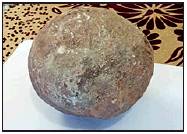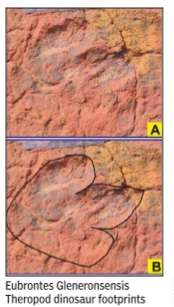Dinosaurs: India
(→Mandla, MP: 2020) |
(→Dhar, MP , 2023) |
||
| Line 18: | Line 18: | ||
DINOSAURS: INDIA]] | DINOSAURS: INDIA]] | ||
| − | == [[Dhar, MP ]], 2023 == | + | ==MP== |
| + | === Mandla, MP: 2020=== | ||
| + | [https://epaper.timesgroup.com/Olive/ODN/TimesOfIndia/shared/ShowArticle.aspx?doc=TOIDEL%2F2020%2F11%2F07&entity=Ar03612&sk=B1456708&mode=text P Naveen, November 7, 2020: ''The Times of India''] | ||
| + | |||
| + | [[File: The Dinosaur egg found in Mandla, MP, 2020.jpg|The Dinosaur egg found in Mandla, MP: 2020 <br/> From: [https://epaper.timesgroup.com/Olive/ODN/TimesOfIndia/shared/ShowArticle.aspx?doc=TOIDEL%2F2020%2F11%2F07&entity=Ar03612&sk=B1456708&mode=text P Naveen, November 7, 2020: ''The Times of India'']|frame|500px]] | ||
| + | |||
| + | A child playing with ‘round stones’ and a Jurassicbuff government schoolteacher crossed paths in a farm in Mandla district of Madhya Pradesh, leading to the discovery of 65-million-year-old dinosaur eggs of a species never before seen in India. | ||
| + | |||
| + | The site is located around 80km from Bara Simla hills of Jabalpur, where the first dinosaur fossils in Narmada Valley were discovered in 1828 by Captain William Sleeman. Since then, fossils of a variety of dinosaurs have been found in various parts of Narmada valley. | ||
| + | |||
| + | The latest find was purely by chance. “I was out on a morning walk near Mohantola locality when I saw a young boy playing with a ball-shaped stone. When I asked him to give it to me, he refused and said I could find more such ‘balls’ near a pond, which was being dug. I followed his directions and reached the site where I found a cluster of seven such ‘balls’. I knew instantly that they were fossilised eggs,” Prashant Shrivastava, a 49-year-old teacher from Mandla, told TOI. | ||
| + | |||
| + | The pond is in someone’s farmland. The site where the eggs were found was a dinosaur nest, said Prof P K Kathal, a palaeontologist from the Centre of Advanced Study in Geology at Dr Harisingh Gour Vishwavidyalaya, who authenticated the fossilised eggs. “The eggs are from the Upper Cretaceous period, and seem to belong to a new species of beaked or sauropod dinosaur hitherto unknown in India,” Kathal said. | ||
| + | |||
| + | === [[Dhar, MP ]], 2023 === | ||
[https://timesofindia.indiatimes.com/city/indore/256-fossilised-eggs-of-titanosaur-found-in-madhya-pradeshs-dhar/articleshow/97187608.cms Salil Mekaad, January 21, 2023: ''The Times of India''] | [https://timesofindia.indiatimes.com/city/indore/256-fossilised-eggs-of-titanosaur-found-in-madhya-pradeshs-dhar/articleshow/97187608.cms Salil Mekaad, January 21, 2023: ''The Times of India''] | ||
| Line 59: | Line 73: | ||
[[Category:India|D DINOSAURS: INDIADINOSAURS: INDIA | [[Category:India|D DINOSAURS: INDIADINOSAURS: INDIA | ||
DINOSAURS: INDIA]] | DINOSAURS: INDIA]] | ||
| − | [[Category:Pages with broken file links|DINOSAURS: INDIA]] | + | |
| + | [[Category:Fauna|D DINOSAURS: INDIADINOSAURS: INDIADINOSAURS: INDIA | ||
| + | DINOSAURS: INDIA]] | ||
| + | [[Category:India|D DINOSAURS: INDIADINOSAURS: INDIADINOSAURS: INDIA | ||
| + | DINOSAURS: INDIA]] | ||
| + | [[Category:Pages with broken file links|DINOSAURS: INDIADINOSAURS: INDIA | ||
| + | DINOSAURS: INDIA]] | ||
=Footprints= | =Footprints= | ||
Revision as of 17:56, 19 December 2023
This is a collection of articles archived for the excellence of their content. |
Contents |
Eggs
MP
Mandla, MP: 2020
P Naveen, November 7, 2020: The Times of India

From: P Naveen, November 7, 2020: The Times of India
A child playing with ‘round stones’ and a Jurassicbuff government schoolteacher crossed paths in a farm in Mandla district of Madhya Pradesh, leading to the discovery of 65-million-year-old dinosaur eggs of a species never before seen in India.
The site is located around 80km from Bara Simla hills of Jabalpur, where the first dinosaur fossils in Narmada Valley were discovered in 1828 by Captain William Sleeman. Since then, fossils of a variety of dinosaurs have been found in various parts of Narmada valley.
The latest find was purely by chance. “I was out on a morning walk near Mohantola locality when I saw a young boy playing with a ball-shaped stone. When I asked him to give it to me, he refused and said I could find more such ‘balls’ near a pond, which was being dug. I followed his directions and reached the site where I found a cluster of seven such ‘balls’. I knew instantly that they were fossilised eggs,” Prashant Shrivastava, a 49-year-old teacher from Mandla, told TOI.
The pond is in someone’s farmland. The site where the eggs were found was a dinosaur nest, said Prof P K Kathal, a palaeontologist from the Centre of Advanced Study in Geology at Dr Harisingh Gour Vishwavidyalaya, who authenticated the fossilised eggs. “The eggs are from the Upper Cretaceous period, and seem to belong to a new species of beaked or sauropod dinosaur hitherto unknown in India,” Kathal said.
Dhar, MP , 2023
Salil Mekaad, January 21, 2023: The Times of India

From: Salil Mekaad, January 21, 2023: The Times of India
INDORE: Scientists have found 256 fossilised eggs of titanosaur- one of the largest known dinosaurs -- in Dhar district of Madhya Pradesh, drawing parallels between the egg-laying pattern of extinct species to modern day crocodiles and birds.
The fossilised eggs found in 92 titanosaur clutches -- Upper Cretaceous (Maastrichtian) Lameta Formation -- also reveal how the dinosaurs lived, the manner in which they laid eggs away from their habitat area and conditions prevailing during their existence in the area 100.5million to 66 million years ago.
A study, published in open-access journal PLOS ONE by Harsha Dhiman of the University of Delhi, New Delhi and colleagues, opens avenues to additionally understand more about titanosaur palaeobiology and to qualitatively understand preservation and taphonomical aspects of their egg clutches.
Researchers gear up to carry out CT scans of areas
The researchers are now gearing up to carry out CT scans of the area, expecting to find the first dinosaur embryo in India.
"We have found six oospecies. The study of egg-laying patterns showed similarities to that of modern day crocodiles and birds," Harsha Dhiman told TOI.
Crocodiles lay eggs in clutches and bury them. "We found that the titanosaur eggs were laid in clutches and partially buried in shallow pits," she said, adding that both multi-shelled and ovum-in-ovo pathologies have been documented in the eggs. The former is common in both reptile and bird eggs, while the latter has so far only been reported from avian eggs.
University of Delhi geology department head Prof GVR Prasad said the multi-shelled eggs also show that the dinosaurs were under considerable stress. "Such phenomenon happens when a new egg is formed over the older one, which somehow is not laid and returns to the ovary. It can happen due to external stress - food scarcity, changes in climate, floods or events that badly affect the animals," he said.
Prof Prasad said the study gives strong evidence of dinosaurs falling under the clade archosauria - crocodiles and birds are the only living representatives of the category.
The researchers carried out investigations between 2017 and 2020 and found extensive hatcheries of dinosaurs in Bagh and Kukshi areas in Dhar district - in villages Akhada, Dholiya Raipuriya, Jhaba, Jamniapura, and Padlya. Experts are working on getting a Unesco Global Geopark status for the area to pave the way for further studies.
The recent study did not find body and bone fossils of dinosaurs near the nesting sites. "This indicates that the titanosaurs laid eggs at places other than where they lived, " said Dhiman, adding the egg-laying pattern seen in the fossils shows that the nests were not supervised.
"It also suggests that micro-excavation is needed to ascertain if body fossils can also be found in the area, to give a new direction to the theory," she said.
Now, the researchers are chalking out plans to go deeper into the fossils and expect surprises. "If we find an embryo, it would be the first in India," Dhiman said.
The researchers found diversity in the form of six oospecies. But Prof Prasad says that it cannot be concluded that the same diversity existed among the dinosaurs. It must be corroborated with body fossils.
"If skeletal remains inside the eggs, embryo could be found, it would give better clarity," Prof Prasad said.
The researchers are now trying to locate micro CT scan facilities in India that could give better 3D images to study the eggs without damaging them.
Footprints
Rajasthan, 2016

The Times of India, Jun 13 2016
Vimal Bhatia
150m-year-old dino footprints found in Rajasthan
A team from the geological department of Jainarayan Vyas University , Jodhpur, has discovered 150 million-year-old footprints of Eubrontes Gleneronsensis Theropod dinosaurs in Lathi formation in Jaisalmer district. These carnivores were 1-3 metres in height and seem to belong to the coastal environment.
Fossils of Eubrontes Theropod dinosaurs have been found worldwide in France, Poland, Slovakia, Italy, Spain, Sweden, Australia and the US. The footprints of Eubrontes Gleneronsensis Theropod dinosaurs have been discovered for the first time by Dr Virendra Singh Parihar, Dr Suresh Chandra Mathur and Dr Shankar Lal Nama.
“Morphologically , footprints of Eubrontes Gleneronsesis Theropod dinosaurs are large about 30 cm long, tridactyle, strong with thick toes. Their body is estimated to be 1-3m tall and 5-7m in length,“ Parihar said.“The Katrol formation of Kutch basin and Baisakhi formation of Jaisalmer basin are potential sites for remains of dinosaurs.“ This discovery might open new vistas in searching dinosaur fossils in equivalent rocks. The finding is important as professor Mathur along with his team discovered mass mortality horizon (bone bed) containing fossils of dinosaur, crocodile, gastropods and fishes from Fategarh formation with magnetic spherules. Mathur said this discovery shows the cause and effect relationship and can help to solve the mystery of the extinction of dinosaurs.
Fossils
Jaisalmer 2023
Mohita Tewari, August 8, 2023: The Times of India

From: Mohita Tewari, August 8, 2023: The Times of India
Lucknow : Scientists from IIT-Roorkee and Geological Survey of India (GSI) have discovered the oldest fossil remains of a long-necked, plant-eating dicraeosaurid dinosaur in Jaisalmer, suggesting that India was a major centre of dinosaur evolution.
The study published in ‘Scientific Reports’, an international journal by publishers of Nature, reveals that the remains are 167 million years old and belong to a new species, unknown to scientists thus far. It has been named ‘Tharosaurus indicus’, the first name referring to the ‘Thar desert’ where the fossils were found, and the second after its country of origin.
According to the scientists, fossils of dicraeosaurid dinosaurs have been found previously in North and South Americas, Africa and China, but such fossils were not known from India. “A systematic fossil exploration and excavation programme initiated by GSI in 2018 in the Middle Jurassic rocks in the Jaisalmer region of Rajasthan has led to this discovery,” said Prof Sunil Bajpai, chair professor of vertebrate paleontology in the department of earth sciences at IIT-Roorkee, who carried out a detailed study of the fossils for around five years along with his colleague Debajit Datta, a national postdoctoral fellow.
The rocks in which the fossils were found are dated to be around 167 million years old, which makes this new Indian sauropod not only the oldest known dicraeosaurid but also globally the oldest diplodocoid (broader group which includes dicraeosaurids and other closely related sauropods). Theories so far had suggested that the oldest dicraeosaurid was from China (about 166-164 million years old).